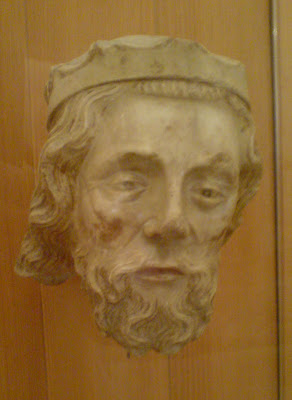 There have been good popes and bad popes, and the fact that there have been rather more of the latter is probably the fault of the Donation of Constantine. This document purported to be a grant of the Western Empire by the eponymous emperor to the bishops of Rome; it was forged in the second half of the eighth century, probably, and taken seriously until the mid-fifteenth. It made the popes into temporal princes, with territories to defend, alliances and treaties to make, and conversely secular enemies. It was this sort of political manouevring that forced the popes to leave Rome in the fourteenth century, and take up refuge in Avignon, in the pocket of the French kings, where they found ways to console themselves for their losses. Most of the Avignon popes lived sybaritic lives, holding the sort of banquets that sound like hard work even to attend, let alone for the servants -- records survive listing for one feast figures like 10 471 hens, 1023 sheep, 46 856 cheeses, etc. The one or two popes who did show some devotion to the church did so by throwing their energies into the ruthless detection and burning of heretics. This makes them unsympathetic, frankly. Cheerful gluttony looks less likeable when you consider what a huge pyramid of people's frank and anxious devotions supported the expenditure.
There have been good popes and bad popes, and the fact that there have been rather more of the latter is probably the fault of the Donation of Constantine. This document purported to be a grant of the Western Empire by the eponymous emperor to the bishops of Rome; it was forged in the second half of the eighth century, probably, and taken seriously until the mid-fifteenth. It made the popes into temporal princes, with territories to defend, alliances and treaties to make, and conversely secular enemies. It was this sort of political manouevring that forced the popes to leave Rome in the fourteenth century, and take up refuge in Avignon, in the pocket of the French kings, where they found ways to console themselves for their losses. Most of the Avignon popes lived sybaritic lives, holding the sort of banquets that sound like hard work even to attend, let alone for the servants -- records survive listing for one feast figures like 10 471 hens, 1023 sheep, 46 856 cheeses, etc. The one or two popes who did show some devotion to the church did so by throwing their energies into the ruthless detection and burning of heretics. This makes them unsympathetic, frankly. Cheerful gluttony looks less likeable when you consider what a huge pyramid of people's frank and anxious devotions supported the expenditure.The local heresy, which still lingered in the mountains, was a kind of Manichaeism, pitting a good god of things spiritual against a bad god of the flesh. A few men, the parfaits, were supported by the people and undertook to abstain from meat (though not fish) and sex, but the majority did just what they felt like, on the grounds that sex with a prostitute or mistress was no more sinful than sex with a wife, etc, and trusting that they could be redeemed by a parfait on their deathbed.
 (After that last-minute purification they were not allowed to eat or drink again and had to starve to death, so they had to hope their relatives had correctly assessed their condition.) It doesn't seem so far removed from the attitude of the popes and cardinals, who must surely have assumed that their lives in the fleshpots could be attoned for in the eyes of God by alms-giving and death-bed confession. The attraction of Catharism seems at least partly to have been hatred of the heavy church taxes which paid for the church's lifestyle. This was the period when it was condemned as a heresy to say that Christ lived without possessions, because it might set a dangerous example.
(After that last-minute purification they were not allowed to eat or drink again and had to starve to death, so they had to hope their relatives had correctly assessed their condition.) It doesn't seem so far removed from the attitude of the popes and cardinals, who must surely have assumed that their lives in the fleshpots could be attoned for in the eyes of God by alms-giving and death-bed confession. The attraction of Catharism seems at least partly to have been hatred of the heavy church taxes which paid for the church's lifestyle. This was the period when it was condemned as a heresy to say that Christ lived without possessions, because it might set a dangerous example.It must be knowing this that gives an odd quality to the surviving papal art in the Petit Palais. It looks almost blatantly secular, without even a mask of piety. Even the carved angels have a distinctly worldly air, while the prophets and apostles look utterly weary, and Christ's gestures seem more rude than benedictional. There are surviving frescos there from a cardinal's house; they show scenes of hunting, dancing, and stolen kisses in beautiful gardens.
The rest of the Petit Palais has a collection of largely Italian art up til about 1550, which feels like a return to seriousness. There are some truly beautiful early icon-style works, and lots of beautifully executed madonnas in rich brocades -- the Pre-Raphaelites would have loved it. It's one of the best art museums I've been to in ages, and surprisingly uncrowded. It's all kept in a huge decorated stone building with stunning views over the Pont St-Bénézet (of the dance) and the Rhône. It was the original papal palace, but was soon found inadequate to their needs, so they built the Palais des Papes.
No comments:
Post a Comment